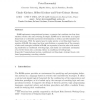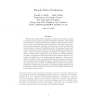1549 search results - page 20 / 310 » On the rules of intermediate logics |
JLP
2008
13 years 8 months ago
2008
Currently known sequent systems for temporal logics such as linear time temporal logic and computation tree logic either rely on a cut rule, an invariant rule, or an infinitary ru...
TCS
2002
13 years 8 months ago
2002
ELAN implements computational systems, a concept that combines two first class entities: rewrite rules and rewriting strategies. ELAN can be used either as a logical framework or ...
AIIA
2005
Springer
14 years 2 months ago
2005
Springer
Machine Learning systems are often distinguished according to the kind of representation they use, which can be either propositional or first-order logic. The framework working wi...
CSL
2009
Springer
14 years 3 months ago
2009
Springer
Separation logic is a Hoare-style logic for reasoning about programs with heap-allocated mutable data structures. As a step toward extending separation logic to high-level language...
ADC
1999
Springer
14 years 1 months ago
1999
Springer
We introduce pseudo-naive evaluation, a method for execution of mixed top-down/bottom-up logic programs and deductive databases. The method is intermediate in power between naive ...


